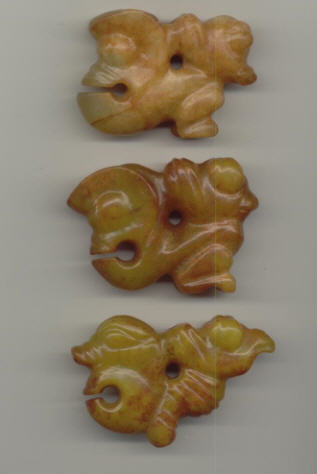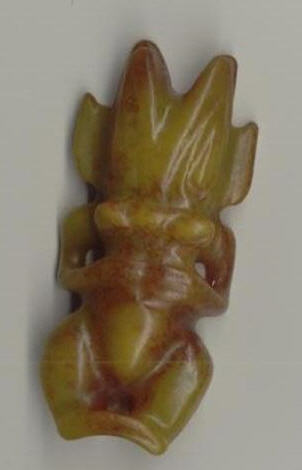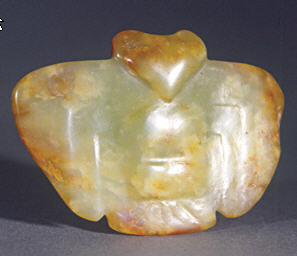Posted By: Bill
Posted Date: Feb 03, 2009 (09:44 PM)
Dear Mircea:
The only reason I found your other piece is when I tried to find more info on your so called "sonorous" jade and I happened to come across another piece that looks exactly like yours (even the background) and in there I found your "authentic" Hongshan piece. It is amazing that you posted your "archaic piece" in this forum to test all the members while you are also trying to sell these other pieces. I found the coincidence simply amazing.
One of the easy ways in determining how good a dealer's items really are is by looking at all the items as a whole. If most of them are questionable then there is very little chance that one will find any authentic pieces there.
I regret to say that I am extremely disappointed with your knowledge in Hongshan jades.
May I respectfully ask you: "Exactly what Hongshan reference books are you using as your references in attributing your authentic Hongshan pieces?"
First of all, in your first statement:
"First of all, there are in existence very few Hong Shan jade carvings."
You need to define how much is a few. Have you ever read my translation of the interview with a news reporter made by the late Mr. Sun ShouDao, one of the top Hongshan jade experts, in China in which he estimated the number of authentic Hongshan jades he believe were still in existence?
Secondly, your statement:
"99% of all Hong Shan carvings are made from hardstone, mostly bowenite (from Inner Mongolia) and a few made from serpentine"
shows your lack of understanding of Hongshan jades because you simply have no clue in what material authentic Hongshan jade carvings were made of.
I advise you to read the article written by Mr. Zhou Nam Quan, another top Hongshan jade expert in China regarding material of authentic Hongshan jade carvings. I had translated the article and posted it in the other jade forum.
Please forgive me for sounding so arrogant because I am not. I am no Hongshan expert, exactly like you said, therefore I have to learn it from the top Hongshan jade experts in China who had personally involved in the excavations and studies of Hongshan jades from known Hongshan sites.
Your statement regarding the material of your authentic Hongshan jade rhyton truly confused me:
"This rhyton jade is extremely rare, probably unique (you did not see one like this, me either). With certitude is not serpentine, but carved from high quality celadon jade."
In your sales listing of this piece, it was clearly described as "nephrite yellow jade carving" and yet in your recent message you now called it "high quality celadon jade", �extremely rare� and is not serpentine." Would you please confirm if you really believe it is yellow or celadon? If it is not serpentine, is it nephrite? If it is not nephrite, is it bowenite? Had you even tested it before you listed the piece? Are you sure what it was made of?
Please allow me to repeat my opinion regarding the material of this HS rhyton:
It was not made of nephrite. It is not rare. It is made of serpentine or bowenite (if it cannot be scratched). I am 90% sure the S.G. of this piece cannot be higher than 2.70 and therefore there is simply no way this piece is made of nephrite. Such a large piece of nephrite did not exist in Liaoning at Neolithic times. Even if it existed, there was simply impossible for the Hongshan people to cut such a large piece and to "carve" it into a rhyton.
I am posting pictures of several pieces of Hongshan style carvings that were made of similar material for you to compare. I am also posting a beautiful Hongsha jade bird for you to see how beautiful a Hongshan jade carvings should look like in both its material and quality of carving.
Your statement "All neolithic carvings are crude" simply cannot apply to Hongshan jade carvings. May I ask where did you learn about the carving technique of Hongshan jade carvings or for that matter that of any Neolithic jade items?
May I recommend the following book to you:
ISBN's: 9570135867
史前琢玉工艺技术 钱宪和 & 方建能
Shiqian zhuoyu gongyi jishu [Prehistoric Jade Carving Techniques]
Qian, Xianhe & Fang, Jianneng Item # 33645 ISBN 9570135867
You see, the reason for so many Chinese and western collectors to go crazy over Hongshan jade carvings is because they may be the "best" jade carvings money can buy with respect to both the quality of the carving skills displayed on them and the material used in "carving" them.
Each piece was painstakingly "carved" (yes I do know that you cannot carve jade but it is easier to use the word) for many years and therefore each authentic piece is a master piece of art.
You really cannot see any tool marks on any authentic Hongshan jade carving because there were three different "carving" techniques being applied in the making of each single carving line. First of all, some types of non-metal tu (bamboo, wood, stone, etc.) compounded with high-hardness grit (such as agate/quartz; I never heard of corundum used by HS) was used to form short and separate horizontal tu lines along the planned long carving line. Then another tu would join all these small horizontal carving lines together by moving vertically inside these horizontal lines, expanding each of them and connected them together. If they stopped right here, it would almost look like a railroad track or the Chinese character 非 fei. However, they would continue to use a rod drill with a high-hardness stone tied on its top, then moved it horizontally back and forth along the long carving lines to smooth out all the vertical carving lines. As a result, it would be very difficult for you to see any types of tool marks. However, sometimes with the assistance of a 10x loupe and by moving the piece in different angles, you would be able to see all three "carving" techniques being seen on top of each other. This type of carving techniques could be found on Hongshan pieces only. They were wildly discussed by all Hongshan jade experts in China but were rarely mentioned in any jade books written by western jade writers.
As to the polishing skill of the Hongshan people, it is bar none, no other cultures or dynasties can even compare with them. I regret to say your piece was made with modern carving tools and polished with modern high speed tools with extremely hard polishing paste such as diamond paste. Its luster is simply much inferior to any authentic Hongshan jade carvings, in my opinion.
Yes, it is true that "small pieces of Hong Shan nephrite sold at auctions in China is in hundreds of thousands of US dollars."
Doesn't your statement contradict with what you said earlier: "99% of all Hong Shan carvings are made from hardstone". How can there be so many pieces of Hongshan nephrite for sale in Chinese auctions when 99% of them were made of hard stones?
Yes, indeed the reason why so many authentic Hongshan jade carvings look like newly made jade carvings with superb luster even after burying in ground for so many years is because:
(1) Most of them were indeed made of high-quality nephrite jade that is in the same quality of Hetian jade. For a while, many Hongshan jade experts in China were genuinely puzzled because they could not figure out how in the world the Hongshan people could have transported such high quality nephrite jade from such far away place - Khotan, XinJiang. Only later when some Chinese University professors had found small samples of high quality nephrite jades in the Hongshan area did they solve such puzzle.
(2) Many jade collectors believe an authentic Hongshan jade carving should be full of corrosion due to its age and should have weathering and corrosion all over its surface. That is far from the truth. Due to the fact that many of them were made of high quality nephrite and many Hongshan tombs were found in higher ground or they were air-tight stone tombs, therefore the burial environment were extremely dry. As a result, many authentic Hongshan jades were preserved in perfect conditions, once cleaned with mild soap and water only, they would have this blinding "gem" luster on them.
Many Hongshan jade collectors mistaken such a natural luster which was resulted from superb polishing skill on superb jade material as a result of "waxing". No waxing can result in such marvelous luster.
Therefore while I respect your status as that of a jade book writer and seemingly know more about jade in general than me, I must caution you in not to speak like a Hongshan jade expert until you have the chance to go to China and study with such Hongshan guru, Mr. Guo Dashun and examine authentic pieces in person under his guidance:
http://www.paragonbook.com/html/browsesubj/fullcitation.cfm?item=31736
That is what I plan to do when I retire.
As a matter of fact, I found many members in the other jade forum are much more serious in the collection of Hongshan jades and they have studied a lot regarding Hongshan jades and seem to know about Hongshan jades than you, from what I have observed so far. May be you should post your Hongshan rhyton there and allow them to appraise it.
Of course, I can very well be wrong with your piece since the picture of your rhytone is simply not good enough to attribute it with 100% accuracy.
Lastly, I am not so sure you should give anybody any quiz about Hongshan jade carvings until you have established that you are indeed an expert in Hongshan jade. Again, no disrespect intended. This is simply a friendly advice. Again, I would like to apologize to you if I have inadvertently hurt your feeling and since you are very willing to learn, I believe may be indeed we can help each other in learning more about Hongshan jades or other aspect of jades.
Thanks.
Bill
P.S. The jade carvings posted by me with similar material as your HS rhyton are by no means authentic. They are for comparison purpose only. However, the HS bird is a great piece.


